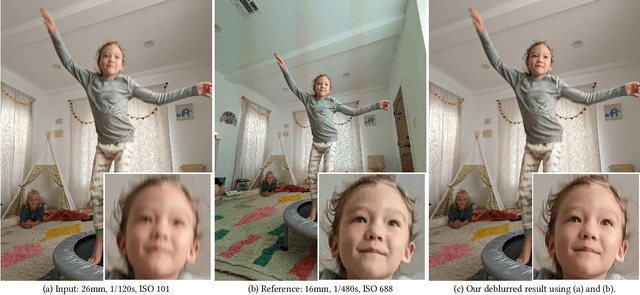YiChang Shih
Efficient Hybrid Zoom using Camera Fusion on Mobile Phones
Jan 02, 2024Abstract:DSLR cameras can achieve multiple zoom levels via shifting lens distances or swapping lens types. However, these techniques are not possible on smartphone devices due to space constraints. Most smartphone manufacturers adopt a hybrid zoom system: commonly a Wide (W) camera at a low zoom level and a Telephoto (T) camera at a high zoom level. To simulate zoom levels between W and T, these systems crop and digitally upsample images from W, leading to significant detail loss. In this paper, we propose an efficient system for hybrid zoom super-resolution on mobile devices, which captures a synchronous pair of W and T shots and leverages machine learning models to align and transfer details from T to W. We further develop an adaptive blending method that accounts for depth-of-field mismatches, scene occlusion, flow uncertainty, and alignment errors. To minimize the domain gap, we design a dual-phone camera rig to capture real-world inputs and ground-truths for supervised training. Our method generates a 12-megapixel image in 500ms on a mobile platform and compares favorably against state-of-the-art methods under extensive evaluation on real-world scenarios.
Face Deblurring using Dual Camera Fusion on Mobile Phones
Jul 23, 2022



Abstract:Motion blur of fast-moving subjects is a longstanding problem in photography and very common on mobile phones due to limited light collection efficiency, particularly in low-light conditions. While we have witnessed great progress in image deblurring in recent years, most methods require significant computational power and have limitations in processing high-resolution photos with severe local motions. To this end, we develop a novel face deblurring system based on the dual camera fusion technique for mobile phones. The system detects subject motion to dynamically enable a reference camera, e.g., ultrawide angle camera commonly available on recent premium phones, and captures an auxiliary photo with faster shutter settings. While the main shot is low noise but blurry, the reference shot is sharp but noisy. We learn ML models to align and fuse these two shots and output a clear photo without motion blur. Our algorithm runs efficiently on Google Pixel 6, which takes 463 ms overhead per shot. Our experiments demonstrate the advantage and robustness of our system against alternative single-image, multi-frame, face-specific, and video deblurring algorithms as well as commercial products. To the best of our knowledge, our work is the first mobile solution for face motion deblurring that works reliably and robustly over thousands of images in diverse motion and lighting conditions.
Correcting Face Distortion in Wide-Angle Videos
Nov 18, 2021



Abstract:Video blogs and selfies are popular social media formats, which are often captured by wide-angle cameras to show human subjects and expanded background. Unfortunately, due to perspective projection, faces near corners and edges exhibit apparent distortions that stretch and squish the facial features, resulting in poor video quality. In this work, we present a video warping algorithm to correct these distortions. Our key idea is to apply stereographic projection locally on the facial regions. We formulate a mesh warp problem using spatial-temporal energy minimization and minimize background deformation using a line-preservation term to maintain the straight edges in the background. To address temporal coherency, we constrain the temporal smoothness on the warping meshes and facial trajectories through the latent variables. For performance evaluation, we develop a wide-angle video dataset with a wide range of focal lengths. The user study shows that 83.9% of users prefer our algorithm over other alternatives based on perspective projection.
 Add to Chrome
Add to Chrome Add to Firefox
Add to Firefox Add to Edge
Add to Edge